Walking with a prosthetic leg is not just about moving forward. It’s about feeling steady, confident, and natural with every step. At the heart of many above-knee prosthetics is a complex and important part — the knee mechanism. The way this artificial knee works can make a big difference in how easy and comfortable walking feels.
Today, there are three main types of prosthetic knee mechanisms: hydraulic, pneumatic, and microprocessor-controlled. Each has its own strengths and special features. Choosing the right one depends on a person’s lifestyle, needs, and goals.
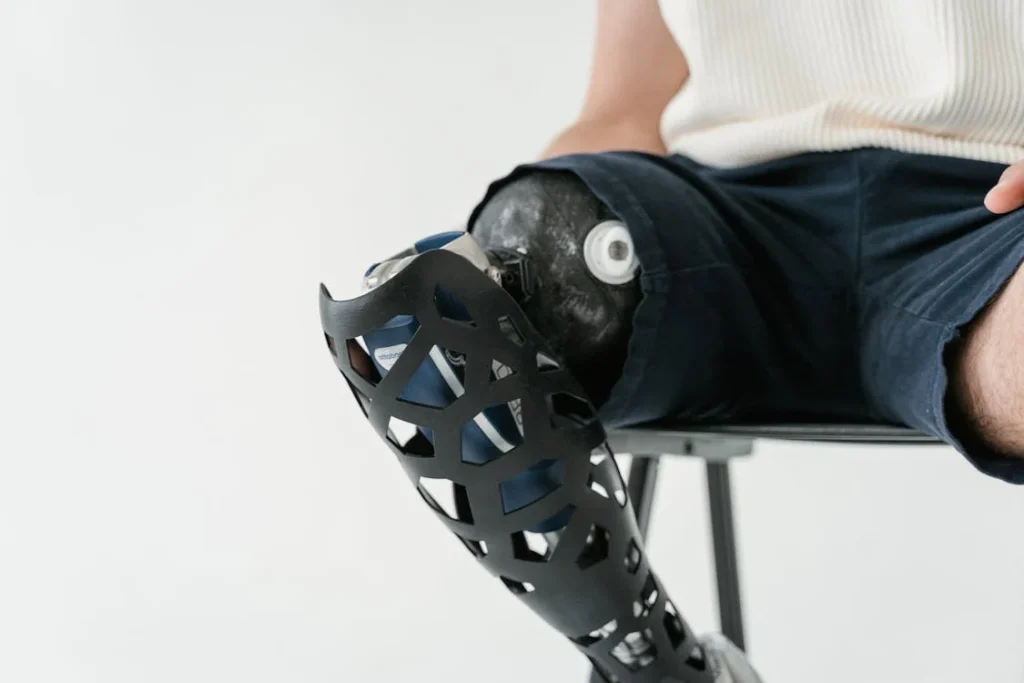
Understanding Hydraulic Prosthetic Knee Mechanisms
How Hydraulic Knees Work
A hydraulic prosthetic knee uses fluid, usually a special type of oil, to control how the knee moves. Inside the knee, there are small chambers filled with this fluid.
As the person walks, the fluid moves through tiny valves, slowing down or speeding up the bending and straightening of the knee.
This controlled movement makes walking feel smoother and more natural. It also helps create a soft, steady pace, even when walking at different speeds.
Whether someone is strolling slowly through a park or walking briskly across a busy street, a hydraulic knee adjusts without needing a lot of effort or thought.
At Robobionics, we pay close attention to how we set up these hydraulic systems. We believe a knee should respond to the user, not the other way around. Our goal is always to make the prosthetic feel like an extension of the body, not a mechanical tool that needs constant managing.
The Advantages of Hydraulic Systems
One of the biggest benefits of a hydraulic knee is how well it handles changes in walking speed. Unlike basic mechanical knees that work best only at a steady pace, hydraulic knees allow a person to speed up or slow down naturally.
This makes everyday activities like crossing a street, climbing stairs, or walking with friends much easier and more comfortable.
Another strength of hydraulic systems is how they help with stability. The fluid movement inside the knee can resist sudden drops or quick bending. This can help prevent falls and make standing and sitting feel safer and more controlled.
Hydraulic knees are also great for people who love staying active. Whether it’s casual hiking, long walks, or even light jogging, the knee can adapt to the user’s rhythm.
It supports a flexible and dynamic lifestyle, giving users the freedom to move the way they want.
At Robobionics, we have seen firsthand how switching to a well-tuned hydraulic knee has given many of our users a new sense of confidence. They feel more secure, more natural, and more in control of their movements, whether they’re out on an adventure or simply navigating their daily routines.
Things to Consider with Hydraulic Knees
While hydraulic knees offer many benefits, they are not perfect for everyone. Because the system depends on moving fluid, it can be a little heavier compared to simpler knee designs.
For some users, especially those with lower strength or smaller body frames, this extra weight might feel tiring over a long day.
Also, hydraulic knees need regular maintenance. Over time, the fluid can lose its perfect balance, and the valves might need adjusting.
At Robobionics, we make this maintenance as easy as possible by offering fast, local service through our partner clinics, so users never have to worry about long waits or complicated repairs.
Choosing a hydraulic knee means thinking about the trade-off between performance and maintenance. For many active users, the benefits of a smoother, more natural gait are well worth it.
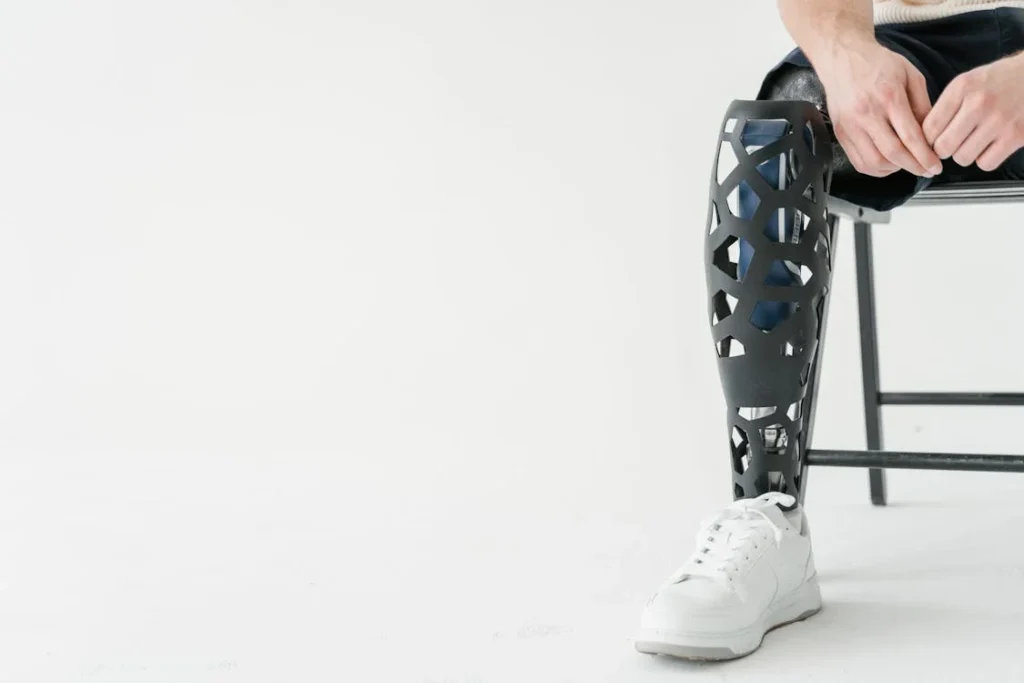
Exploring Pneumatic Prosthetic Knee Mechanisms
How Pneumatic Knees Work
Pneumatic prosthetic knees work in a way that is similar to hydraulic ones, but instead of using fluid, they use air. Inside the knee, there is a cylinder filled with compressed air.
As the person bends or straightens their leg, the air moves through valves, controlling the speed and force of the movement.
Because air is lighter than fluid, pneumatic knees often feel lighter to wear. They allow a soft, cushioned motion that can make walking feel more natural, especially for users who do not need heavy-duty support for fast or aggressive movements.
At Robobionics, we often recommend pneumatic knees for users who want an easy, lightweight solution for everyday activities. They offer a balance between smooth motion and comfort without adding too much weight to the leg.
The Strengths of Pneumatic Systems
One of the most noticeable strengths of pneumatic knees is how gentle and forgiving they are. For users who are walking at a steady, moderate pace, the knee helps create a smooth and comfortable gait.
It cushions each step, reducing the jarring impact that sometimes comes with simpler mechanical knees.
Pneumatic systems also allow some variation in walking speed. They can adjust slightly as a person speeds up or slows down, though they are generally best for steady, consistent movement.
Users who enjoy daily walks, casual outings, or a moderately active lifestyle often find pneumatic knees a very good match.
Another advantage is the lower weight. For users who find heavier prosthetics tiring or uncomfortable, a pneumatic knee can offer a refreshing sense of lightness and ease.
This can be especially important for older adults or those with less muscle strength.
At Robobionics, we believe that comfort is just as important as performance. We make sure every pneumatic knee we fit is adjusted carefully to match the user’s stride, strength, and daily needs, helping them feel at ease from the first step.
Considerations with Pneumatic Knees
While pneumatic knees offer many advantages, they do have their limits. Because air is more easily compressed than liquid, pneumatic systems sometimes lack the same strong resistance and power that hydraulic systems provide.
This means they may not perform as well during very fast, powerful, or uneven movements, such as running, quick turns, or steep slopes.
For users who lead very active or unpredictable lifestyles, a pneumatic knee might feel less responsive in challenging conditions. It’s important to match the knee to the user’s real-world needs and not just their wishes on paper.
Maintenance for pneumatic knees is usually simpler than for hydraulic knees, but it is still important. Seals can wear out, and pressure settings might need fine-tuning over time.
At Robobionics, we offer regular checkups to make sure every prosthetic continues working at its best, avoiding small problems before they become big ones.
Choosing a pneumatic knee is often about prioritizing comfort, weight, and ease of use. For many people, especially those who value simplicity and a light feel, it can be a wonderful choice.
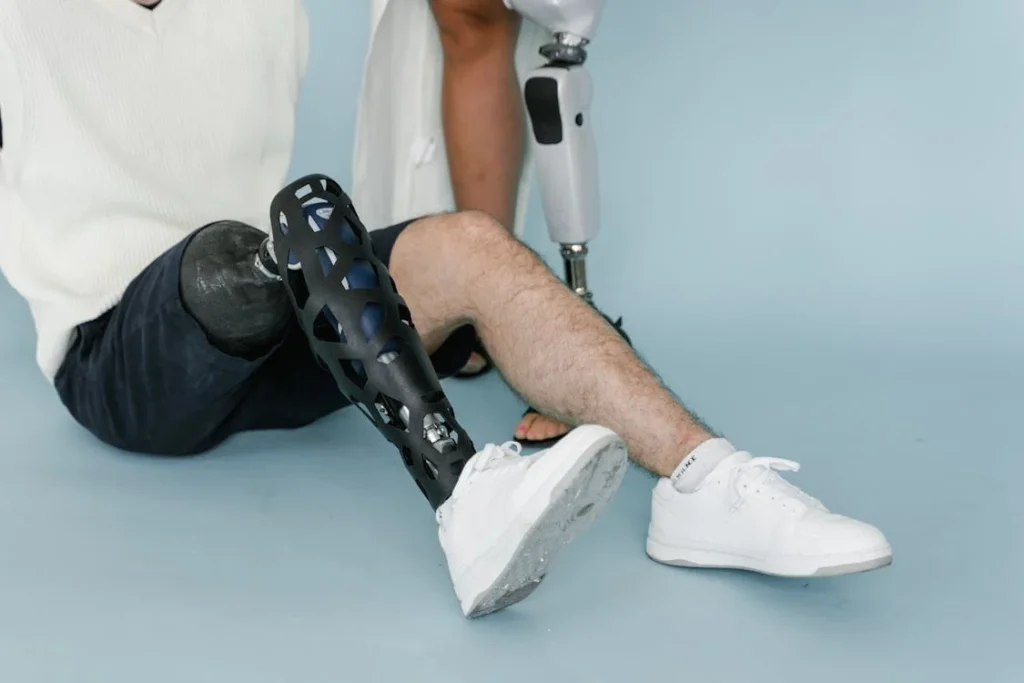
Understanding Microprocessor-Controlled Prosthetic Knees
How Microprocessor Knees Work
Microprocessor-controlled knees represent a big step forward in prosthetic technology. Unlike hydraulic or pneumatic knees, these knees have tiny computers inside them.
These computers constantly read information from sensors placed in the prosthetic. They measure things like the angle of the knee, the speed of walking, and the pressure on the foot.
Every second, the microprocessor makes decisions about how the knee should move. It can tighten, loosen, resist, or allow motion depending on what the sensors tell it.
This happens so quickly and smoothly that users often do not even notice the adjustments. The result is a knee that responds intelligently to how the user is moving, offering support exactly when it’s needed.
At Robobionics, we work with some of the most advanced microprocessor knees available. We carefully program and adjust each device to match the user’s walking style and activities, creating a natural and personalized walking experience.
The Power of Microprocessor Technology
One of the greatest strengths of a microprocessor knee is its ability to adapt instantly to different walking situations. Whether someone is walking slowly, rushing up a flight of stairs, stepping onto a slope, or adjusting balance after a stumble, the knee reads the situation and responds in real-time.
This creates a walking experience that is smoother, safer, and much closer to how a natural knee works.
The stability offered by microprocessor knees is particularly valuable. If a user starts to fall, the knee can detect the sudden change and lock itself to provide extra support.
This can prevent serious injuries and give users much greater confidence when walking in crowded or unpredictable environments.
Microprocessor knees are also wonderful for people who want to enjoy a full range of activities. They can handle slow walks, brisk runs, long hikes, and quick shifts in speed and direction without the user having to manually adjust anything. The smart system takes care of the fine-tuning automatically.
At Robobionics, we see how life-changing these knees can be. Users tell us they feel more independent, more adventurous, and more connected to the world around them because they trust their prosthetic to move with them naturally.
Important Things to Know About Microprocessor Knees
Even though microprocessor knees offer amazing benefits, they are not the right choice for everyone. First, they are usually more expensive than hydraulic or pneumatic options.
The advanced technology and careful calibration mean higher costs, both for the initial fitting and for ongoing maintenance.
Microprocessor knees also need a power source. They run on batteries that must be charged regularly. Most users quickly get used to charging their prosthetic at night, much like they would charge a phone, but it is an extra step that needs to be remembered.
Maintenance for these knees can also be more complex. If something goes wrong, it may require specialized technicians to repair or update the system.
At Robobionics, we make this process as simple as possible by offering easy access to trained experts and fast service, ensuring that users never feel stranded without support.
Choosing a microprocessor knee is often about valuing intelligence, adaptability, and top-level performance. For users who want the best possible walking experience and are ready to invest in maintaining their technology, these knees offer an incredible path to freedom.
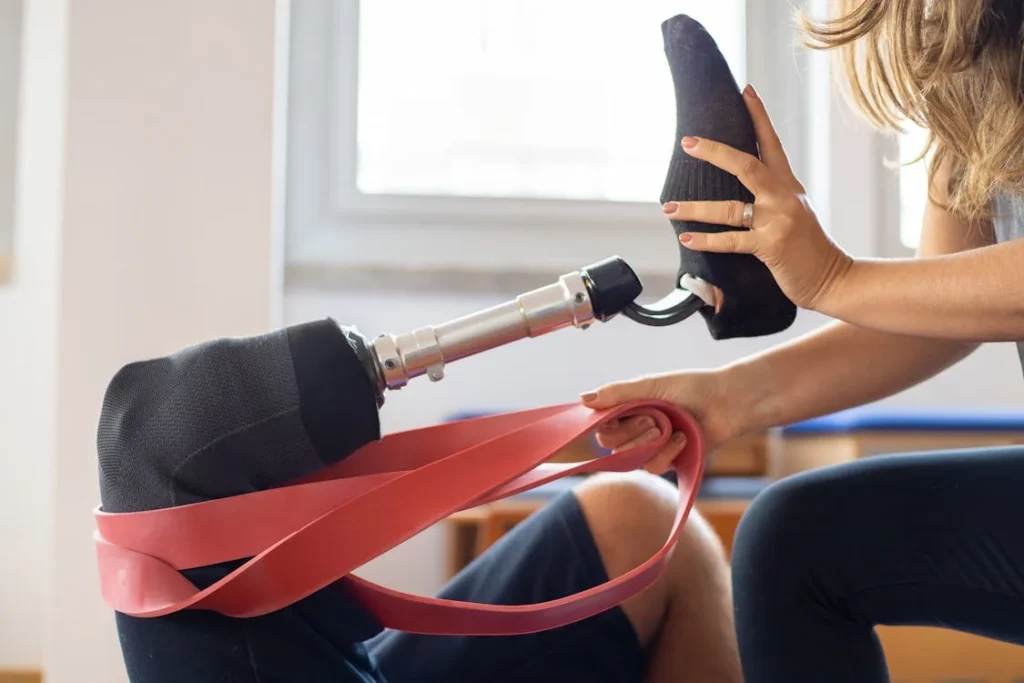
Comparing Hydraulic, Pneumatic, and Microprocessor Knees
Walking Experience and Smoothness
When it comes to the feeling of walking, each knee type offers something different. Hydraulic knees provide a strong, smooth motion that feels very close to natural walking.
They respond well to changes in speed and offer solid support when standing or moving. Pneumatic knees also offer a smooth walking experience, but they feel lighter and are usually better suited for steady, easy paces rather than quick shifts in activity.
Microprocessor knees take the experience even further. They adjust in real-time based on how the user is moving, giving the most natural, flexible, and balanced walk possible.
At Robobionics, we always focus on matching the knee type to how the user actually moves in daily life. It’s not about choosing the most advanced option — it’s about choosing the one that makes walking feel most natural and safe.
Adaptability to Speed and Terrain
Hydraulic knees are great for users who often change their walking speed. They can handle gentle increases and decreases without a problem.
However, when it comes to adapting to very sudden changes, like running up stairs or catching yourself from a slip, they have limits. Pneumatic knees allow for small adjustments but are generally best when the speed stays mostly the same.
Microprocessor knees shine in this area. They are constantly scanning the environment and the user’s body movements. If the terrain changes suddenly — from smooth pavement to rocky ground — the microprocessor adjusts instantly, offering better stability and a smoother gait.
At Robobionics, we recommend microprocessor knees for users who live active, unpredictable lives where quick adjustments and terrain changes are common. For more consistent lifestyles, hydraulic and pneumatic knees still offer excellent support.
Maintenance and Care
Hydraulic knees need regular care to keep the fluid systems working smoothly. Seals can wear out, and occasional adjustments might be necessary to maintain the correct flow and resistance.
Pneumatic knees usually require less maintenance because they use air instead of fluid, but they still need periodic checks to ensure the pressure is right.
Microprocessor knees need more detailed care. Software updates, battery maintenance, and sensor calibration are all important. But with good care, they offer the longest and most adaptive service life.
At Robobionics, we support every type of prosthetic we provide with strong aftercare. We believe users should feel supported not just during fitting, but for the entire life of their prosthetic.
Cost and Accessibility
In terms of cost, pneumatic knees are usually the most affordable, making them a great choice for many users looking for simplicity and comfort.
Hydraulic knees are a bit more expensive, but they bring better performance for active users. Microprocessor knees are the most expensive, reflecting their advanced technology and capabilities.
We at Robobionics are passionate about making all types of prosthetics as accessible as possible. Through local production, partnerships, and personalized fitting services, we make sure that users get the right solution without unnecessary financial pressure.
Choosing a prosthetic knee is not about picking the one that sounds best on paper. It’s about finding the one that matches the user’s lifestyle, comfort, and dreams. That’s the journey we walk together with each person we serve.
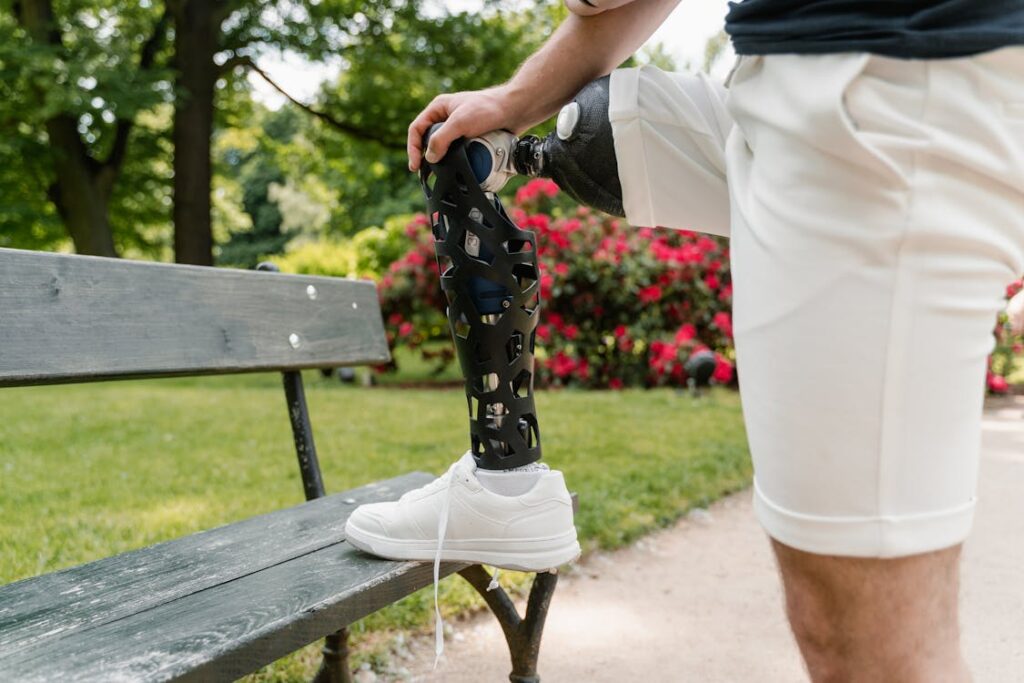
Real-World Stories: How the Right Knee Makes All the Difference
Finding New Freedom with a Hydraulic Knee
One of our users from Ahmedabad, a schoolteacher in her late thirties, had struggled for years with a basic mechanical knee.
She could walk, but every movement felt stiff and uncertain, especially when dealing with stairs or busy streets. After being fitted with a hydraulic prosthetic knee through Robobionics, her experience changed completely.
The hydraulic system allowed her to adjust her pace naturally. She no longer needed to plan every step. Whether hurrying between classrooms or strolling in a park on weekends, her gait felt smooth and steady.
Most importantly, she said she stopped feeling like she was “managing a machine” and started feeling like she was simply moving again. Her story reminds us that the right knee mechanism is not just about movement — it’s about restoring a natural flow to life.
Lightness and Ease with a Pneumatic Knee
Another success story comes from a retired army officer from Pune who lost his limb later in life. Strength and stamina were important to him, but he didn’t need to sprint or run marathons.
What he wanted most was ease and comfort during his daily routines — morning walks, gardening, and spending time with grandchildren.
We fitted him with a pneumatic knee, valuing lightness and simple movement over high-tech features he didn’t need. The result was immediate. He loved the lighter feel, the natural pace, and the fact that he could walk long distances without feeling fatigued.
His feedback often focused not on speed or power, but on the simple joy of moving without thinking about every step.
His journey shows that when prosthetics are matched thoughtfully to a person’s real life, even basic tasks can feel like victories.
High-Performance Living with a Microprocessor Knee
For one of our younger users from Bengaluru, an entrepreneur constantly on the move, a microprocessor knee was the perfect fit.
His daily life involved climbing stairs to client meetings, navigating crowded airports, rushing through busy streets, and occasionally running short distances to catch cabs or trains.
With his previous mechanical knee, these fast changes in pace and terrain were exhausting and risky. After switching to a microprocessor-controlled knee with Robobionics’ personalized fitting and training, his world expanded.
He found that his prosthetic responded immediately when he needed to move faster, change direction, or catch his balance. For him, the freedom to move without hesitation wasn’t just physical — it fueled his confidence in business and social life too.
His story proves how the right technology, when properly fitted and tuned, can support not just movement but ambition and dreams.
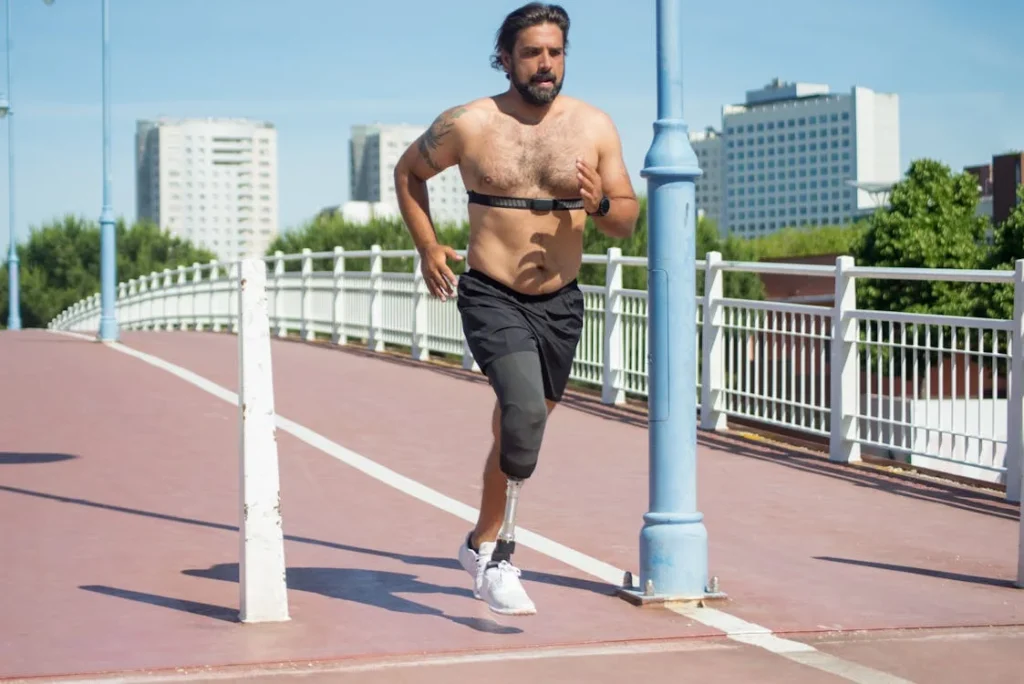
The Future of Prosthetic Knee Technology
Smarter, Faster, and More Personalized
The future of prosthetic knees is full of exciting possibilities. Already, we are seeing microprocessor knees that can connect to smartphones, allowing users to adjust settings quickly depending on the activity they are doing.
Soon, these systems will become even smarter. Future knees might learn from the user’s movements automatically, adjusting in real-time without the need for manual programming or adjustments.
Imagine a prosthetic that senses not just how fast you are moving but where you are — on a slope, in a crowded market, or at home — and changes its behavior to match perfectly.
At Robobionics, we are always looking ahead. We believe that every improvement in sensor technology, data processing, and energy efficiency brings us closer to creating prosthetic knees that feel less like machines and more like natural parts of the body.
Stronger Integration with the Body
Another exciting area of growth is the closer connection between prosthetics and the user’s nervous system. Researchers are working on ways to pick up even more detailed signals from muscles and nerves to control the prosthetic knee.
This means that instead of the knee reacting only to mechanical movement, it could respond directly to the user’s thoughts and muscle intentions.
If successful, this would make movement even faster and more natural. For users, it could feel like having their real knee back — a true extension of their body, not just a tool they control.
At Robobionics, we are investing in research and partnerships to help bring these technologies to life. We believe the best prosthetic is one that blends so closely with the body and mind that users forget it’s even there.
Lighter, Stronger, and More Durable Designs
As materials technology continues to advance, prosthetic knees will become lighter and stronger. Carbon fiber, titanium alloys, and even newer materials not yet widely used in prosthetics will allow for powerful devices that don’t weigh the user down.
These materials also promise longer lifespans for prosthetic components, reducing the need for frequent replacements and repairs.
At Robobionics, we see lightness not just as a comfort issue but as a freedom issue. The less weight the user has to carry, the more energy they can save for living fully, moving confidently, and enjoying life to the fullest.
Making Advanced Knees More Accessible
Finally, one of the most important trends for the future is making advanced prosthetic knees available to more people. Right now, high-end prosthetics are often expensive and out of reach for many.
Robobionics is working hard to change this by focusing on local production, cost-effective design, and strong service networks across India.
We believe that freedom, dignity, and high-quality movement should not be luxuries. They should be rights. As technology advances, we are committed to making sure that no one is left behind.
The future of prosthetic knee technology is bright — and at Robobionics, we are proud to be part of building that future, one step at a time.
Conclusion
Choosing the right prosthetic knee — whether hydraulic, pneumatic, or microprocessor-controlled — can transform daily life. Each type offers its own strengths, from the steady support of hydraulics to the light ease of pneumatics, and the intelligent adaptability of microprocessor systems. The right choice depends on each person’s needs, lifestyle, and dreams.
At Robobionics, we believe a prosthetic should do more than help someone walk. It should help them move freely, confidently, and with joy. Through careful fitting, personal support, and a deep commitment to innovation, we guide each user to the solution that truly fits their life.
As technology advances, prosthetic knees are becoming smarter, lighter, and more human-centered than ever. The future promises even greater freedom — and at Robobionics, we’re excited to walk that journey together.



